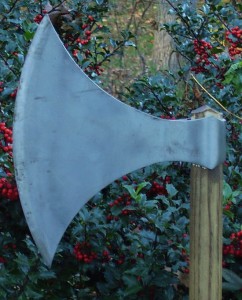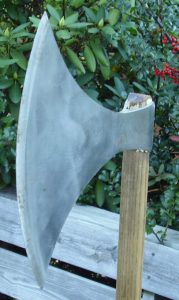 The Danish axe—also called the Dane axe and the great axe—is one of the better-known Norse weapons. Although perhaps not as uniquely Norse as the bearded axe, most military history buffs and many fantasy fans can identify it accurately. The forging techniques and basic construction are very similar to the bearded axe, but both the construction and use of the weapon show important differences as well.
The Danish axe—also called the Dane axe and the great axe—is one of the better-known Norse weapons. Although perhaps not as uniquely Norse as the bearded axe, most military history buffs and many fantasy fans can identify it accurately. The forging techniques and basic construction are very similar to the bearded axe, but both the construction and use of the weapon show important differences as well.
I’m going to take the opportunity to introduce you to a bladesmithing technique early smiths used to save valuable high carbon steel.
It’s Got One Purpose
As we discussed when we talked about the bearded axe, the Vikings clearly distinguished between axes made as tools and those made for war. Bearded axes were used for both, with each axe being made for a specific purpose: some for woodcutting, some for skinning and butchering game, and others for fighting. The Danish axe differs in that, while smiths’ preferences show some variety, every Danish axe was made for war…
The design is pretty straightforward. The overall length is 4-1/2 to 5-1/2 ft. with a hardwood haft. The blade’s cutting edge has a sweeping curve with a cutting edge of 8–12 in. The surprising thing about the Danish ax is the weight; for its size, it’s very light with the head weighing only 2–4 lb. The blade has a very large profile but is less than 1/8 in. thick. The resulting geometry is more like a meat-cutting blade than a wood axe. The result is a very nimble weapon that is light and fast in the hands, with amazing cutting power.
 Shock and Fear
Shock and Fear
A shock weapon has a psychological effect above and beyond its ability to kill. In the modern military, a medium-sized machine gun like the M60 will often fill the shock weapon role in a small unit, especially in ambushes and surprise attacks. Many cultures have an analog, and the Danish axe certainly fits the bill.
The mere sight of howling, charging Norsemen wielding this weapon caused panic in the ranks and a loss of discipline. The accompanying flight of heavy spears only enhanced the effect. This shock effect and the accompanying fear should be accounted for in any encounter involving this weapon.
In Melee
The thin geometry of this blade means it is best used against unarmored or lightly armored targets. The blade shape, long handle, and light weight mark this as a slashing weapon; somewhat of a surprise for an axe, and a big axe at that. This axe makes for fast moves and high-powered cuts as well as quick recovery and redirection. The sweeping blade and long cutting edge make this a terrifying weapon.
Although not truly bearded, the ends of the cutting edge (called the heel and toe) of a Danish ax project up and down enough to effectively jab and, in a pinch, could be used to hook. The length allows attacks over and around shields and perhaps even past the first rank to hit a target in the second rank—a nasty surprise for the relief warrior waiting for his turn on the front line.
Forging the Great Axe
Like the bearded axe, the Dane axe is forged by folding a steel bar over and forge welding it to itself. An eye is left to accommodate the haft, and the blade and eye are forged to shape. The axe head is rough ground to remove the forge scale, heat treated, finish ground and generally cleaned up, and finally fitted on a hardwood haft. The end of the haft is split and a wedge inserted, effectively locking the axe head on the haft.
 A Steel Saving Trick
A Steel Saving Trick
We’ve talked before about what a precious commodity steel has been throughout history. Making steel required an enormous expenditure of time and resources, so every bit had to be used as efficiently as possible. During a smelt, wrought iron, low-carbon steel, and high-carbon steel are produced (sometimes there’s cast iron, but that’s not important now). Only the edge of an axe blade needs high carbon, because that’s the only part that needs to be hardened. To save that precious high carbon steel, a smith forges the axe head out of iron or low carbon steel but leave the edge unwelded and flared open. A high carbon steel bit is then forge welded in, the edge forge welded closed, and the axe is finished as described above.
A Custom Danish Axe
The axe pictured is a Petersen type M (while you’re surfing for Petersen types, check out the Oakeschott typology system also), and was started by an immensely talented swordsmith named Paul Champagne. I had the good fortune to meet Paul and have admired his work for a long time. When this axe came into my possession, the forging was complete as well as the rough grinding. I’ll be doing some engraving and carving, heat treating, and final grinding the beast. I think I’ll keep this one for myself.


Love this series.
But if this is named a great axe, I would say it looks like a battleaxe to me in game terms, do we have even larger axes than this one? Do massive two-headed axes exist which require two hands to wield? Or are the a fantasy?
the = they
@Darkjoy – To be clear this is a two handed axe. A number of cultures have two bladed axes but to my knowledge they are smaller one handed weapons.
In my opinion double bladed great axes are purely fantasy. If someone can find a real life example I’d love to hear about it.
This weapon is wonderful and terrible to behold! I too am enjoying this series. Well written!
Todd,
Ok, rereading the dimensions, 130-160 centimeters does mean that you really need both hands to swing it.
Were there any axes with the same axehead, but fitted on a smaller haft?
@James Thomas – Thank you!
@Darkjoy – I’m not aware of any, and I just did some quick research and couldn’t find any that I’m completely comfortable are authentic other than 17-19th century executioners axes, and they’re a whole different animal. Sorry to disappoint – I’d have much prefered to have found something. :(
I have a replica of this ax [weighs 4 lbs 1 oz.] that I have swung [I have about 25 years in martial arts, east and west, and historical re-enactment] and it is incredibly nimble, quick and lethal. It can spear with the beak and hook with the beard, it goes neatly around blocks and shields and it is it extremely versatile. I have not seen it myself, but a friend tells me that he did armor-testing against a riveted mailshirt and the axe split the rings and penetrated the mail. My vote for nastiest weapon of the dark ages by far.
Baelor, once I realized the size we’re talking about… 4 or 5 foot haft is a polearm!
I’m a little jealous of anyone who has gotten to swing one around, and it definitely sounds truly, spectacularly lethal.
I know I’ve said this before, but man, is this an educational series. Thanks!
http://en.wikipedia.org/wiki/Labrys
The haft would probably be too small to count as a greataxe in pathfinder terms though.
As usual another great read.
@Baelor – Yes, to me it’s actually surprising how fast and light this axe is.
If it’s cutting through a metallic mail (regardless of type) it’s an indication that it’s an effective hacking weapon also, as mail is generally impervious to slashing. Very interesting observation.
@Wolfgang – It’s a polearm indeed! You should put one on your Deepkolt gift list…
@Colin McComb – Thanks! We’ve got some angles planned to keep things interesting, and feel free to make suggestions!
@nermal2097 – Thanks, and interesting link.
The ax as a nimble weapon. That’s not what’s usually associated with the ax in the collective unconsiousness. But it would explain the prevalence in Norse cultures.
(I’m a big believer in function over form for tools. There’s a *reason* spears and swords are the primary weapons of most human cultures: they are very, very good at killing people.)
@thorr-kan – I agree, and especially spears. Swords were for the rich, spears for the masses.
As a fan of all those yari/spear polearms in Japanese myth and legend, I’d love to see a column devoted to the not-so-humble spear at some point.
@Wolfgang – I’m thinking maybe even a short series. There are so many types of spears that they really can’t be covered effectively in a single article. The yari blade alone is so different it’s worthy of its own piece.
Wolfgang, please please *please* tell me that all of Todd’s articles are going to be collected up and made available someday. Yes, this is something I would happily pay for.
I’m terribly afraid I’ve missed some of them.
…And on the subject of cutting through armor:
Many years ago at DragonCon, Hank Reinhardt used a hat-maker’s dummy and a chainmail coif to demonstrate sword versus chain. A palm-sized patch of chainmail was sheared away, and the dummy was much worse for the wear. However, the rings were butted, not riveted, and Mr. Reinhardt was of the opinion that this made a significant difference in the armor’s strength.
On the other hand, he also noted that both kinds of armor would still have allowed the wearer’s skull to be fractured – which is why warriors who could afford helmets wore them!
@Charles – Only Wolfgang can say if there will be a PDF compilation, but in the meantime, try this link for “back issues”:
http://www.koboldquarterly.com/k/tag/weapons
Although I’m far from an expert on armor and its construction, I concur with Mr. Reinhardt’s assessment that riveted mail is stronger than butted. Because the riveted mail has the ends of the rings mechanically attached they will be harder to open.
If I ever have the time and resources I’d very much like to run some tests of the kind you describe. Good times…
Thanks for the link! :)
@Charles Carrier – I live to serve. :)